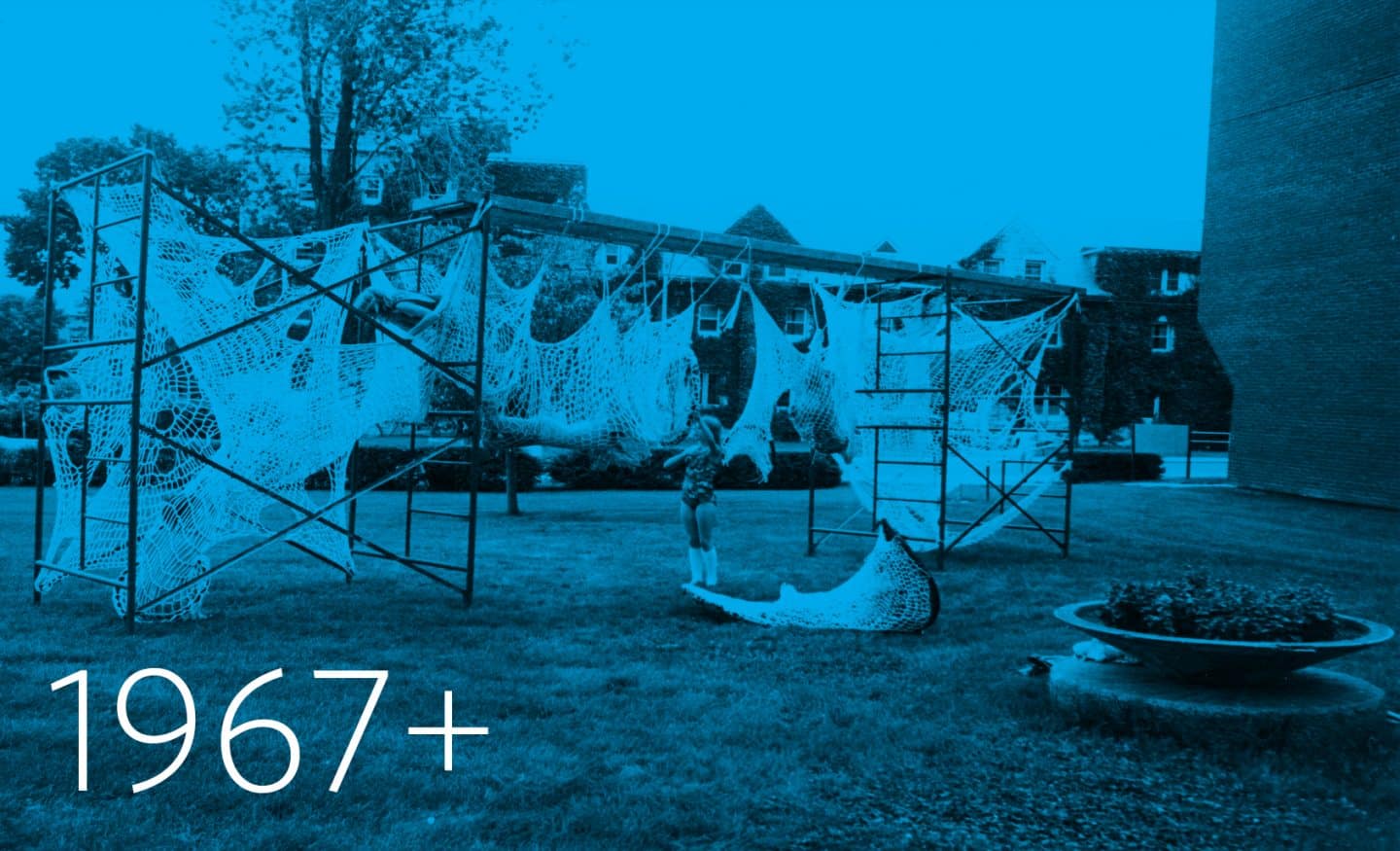
Girolamo da Santracroce, Salvator Mundi, after 1556, oil on canvas. Gift of Dr. and Mrs. Alfred Bader, 1967 (10-011)

In Canada’s centennial year, Queen’s University alumnus Dr. Alfred Bader donates Girolamo da Santacroce’s Salvator Mundi (1520s), the first of his many significant gifts of art. This gift, a painting, is prompted by a request from Professor Gerald Finley in the Department of Art History to loan a work of art for an exhibition of Renaissance prints and drawings. The show, which is held in conjunction with a university-wide seminar on the Renaissance, corresponds beautifully with Dr. Bader’s desire that Queen’s students and faculty have access to great works of European art.
The Agnes publishes The Permanent Collection of Paintings, Sculpture and Drawings catalogue, meticulously compiled and researched by Frances K. Smith. With 300 illustrations, the publication reveals a growing collection. As of 2017, the collection numbers over 17,000 works with strengths in contemporary art, Indigenous art, Canadian historical art including dress and decorative arts of the region, 17th-century Dutch and Flemish painting, and historical art of Central and West Africa.
The exhibition British Domestic Silver features exquisite 17th- to 19th-century pieces from the collection of brothers Drs. Stuart W. and J. F. Houston, donated in 1967. The Houston gift launches the Agnes’s silver collection, later augmented by the domestic silver of prominent Kingston and Eastern Ontario families: the Macaulays and Kirbys, the Etheringtons and Richardsons, and the Mathesons.
The Agnes’s activities are aided this year by their first Canada Council grant. In previous years, the George Taylor Richardson Fund and university operating funds were the primary sources for exhibition and programming costs.
After the Agnes’s founding, many historical Indigenous objects originally housed in the Miller Museum and elsewhere on Queen’s campus are transferred to the gallery’s collection. In the late 1960s and early 1970s, documentation and research of these objects begin in earnest by Frances K. Smith and part-time researcher Jill A. Willmott. Included among these are remarkable historical objects from Nunavik, British Columbia and Northwest Territories donated to Queen’s by Hudson’s Bay Company trader, The Honourable Robert Hamilton, in the 1870s; and the Constantine Collection of Yup’ik, Iñupiaq and Athabascan objects acquired by Agnes Etherington for Queen’s in 1929.
Willmott curates the first exhibition drawn from this transferred collection, The Art of Smoking in Aboriginal North America.
The exhibition Gift from the Douglas M. Duncan Collection and the Milne-Duncan Bequest travels to the Agnes. This show features works from the National Gallery of Canada, part of the dispersal of the major Toronto art dealer’s estate to forty-five galleries and universities nationwide. The Agnes receives sixty works from the Duncan estate for the collection, augmenting its historical Canadian holdings.
In its early years, the Agnes primarily presents exhibitions circulated by other art institutions or organized by local or university groups. By the 1970s, exhibitions are increasingly originated by gallery staff.
As part of the Agnes’s diverse programs, an exhibition of twenty-four scroll paintings by Ma Shiu-Yu and Cho Kuen-Kuen is organized in co-operation with the Chinese Club of Queen’s University and sponsored by the Chinese Student Union of Canada. During the exhibition, the Chinese Club also hosts China Night in nearby Grant Hall. The Agnes previously collaborated with the Chinese Club in 1965 to present an exhibition and painting demonstration by noted artist Kung Fu Ng.
A tribute to Kingston’s tercentenary, the monumental exhibition Heritage Kingston brings together over 260 historical and artistic objects, reflecting on the city’s past, with a comprehensive publication by Art History Professor J. Douglas Stewart and University Archivist Ian E. Wilson. The exhibition is installed as a complex series of mini-galleries, featuring maps, archeological artefacts, watercolour landscapes, painted portraits, architectural drawings, photographs and historical objects from private and public collections, as well as period rooms designed by local architectural historian Jennifer McKendry.
Tradition+1: Patchwork Quilts from South Eastern Ontario, curated by artist Kim Ondaatje, launches a highly successful two-year tour across the country, accompanied by a catalogue and a film. The quilts are primarily made of new materials to withstand the rigours of travel. As part of the project, Ondaatje also commissioned two Jet quilts based on her own patterns, using a 20th-century symbol. The exhibition is at the forefront of renewed interest in quilts, not only as traditional craft, but also as women’s work and works of art.
From Women’s Eyes: Women Painters in Canada, organized by the Agnes for International Women’s Year, is the first thematic exhibition to explore the work of Canadian historical women artists. Curated by Dorothy Farr and Natalie Luckyj, the exhibition and publication become landmarks in the field of Canadian art history, laying the foundation upon which feminist study continues to build. Farr later succeeds Frances K. Smith as the Agnes’s curator.
At the same time, the second facility extension of the Agnes formally opens, providing a new gallery and enlarged storage, as well as adjacent laboratory space for Queen’s new Master of Art Conservation program.
At the forefront of contemporary art movements, the Agnes presents Celebration of the Body in the summer. Curated by conceptual art collective N. E. Thing Co. Ltd., the exhibition comprises installations, art performances and film screenings, demonstrating the place of the body in athletics and visual arts, along with a significant publication. Celebration of the Body is part of the cultural arm of the Summer Olympics, funded through special allocation along with other arts initiatives in Kingston, where the sailing competitions are held.